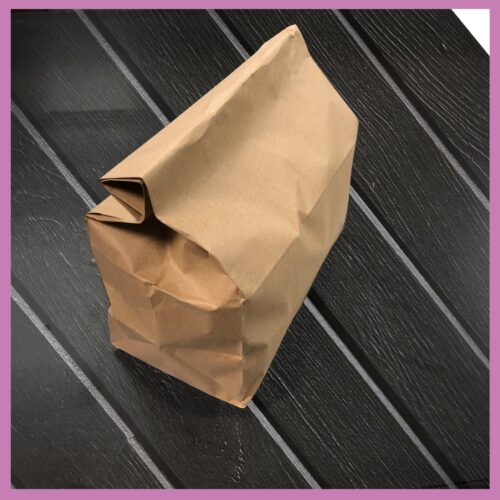
22nd March 2021
Understanding Paper bags….. by Kevin at Advance Bunzl
Paper bags look quite straight forward until you need to order some and then you realise it is not that easy as there are a myriad of questions and variables all wrapped up in jargon.
Hopefully the following paragraphs will assist, so that you can order with confidence when the need arises.
Block bottom or Flat and satchel?
Well a block bottom bag or SOS bag is as the name suggests a bag with a block bottom, the most common we see are flour, sugar or popcorn bags. SOS does not mean “Save Our Souls” in this case but Self Opening Sachet.
A flat bag, also known as counter bag is a bag which tends to be used and filled at point of sale. A satchel bag is also a flat bag that has a gusset both sides which will increase the capacity of the bag when it being filled. A classic flat and satchel bag would be a bread bag.
What size or dimensions do you require?
This can be tricky as there are no set protocols, just custom and practice. The industry mixes up imperial and metric and the presentation of the gusset is different in imperial to metric which I will explain.
Let’s start with a block bottom bag:- 160+80 x 350mm (w:80)
It looks like an algebraic equation but what it means is a 160mm wide bag plus an 80mm gusset each side which will end up being the depth when fully filled. (Open out the gusset and measure from edge to edge to get the gusset size.). It is 350mm high and the final part on this bag is that it has a window 80mm wide. Because the window is quite narrow it can be described as a strip window.
Just to recap Width + Gusset x Height (window) is a good way to express dimensions.
Flat and satchel bags are often referred to in imperial. For example 7 x 7, 8 x 8 or 10 x 10’s. These are inches and often do not even have the “ shown to help. Metric measurements tend to be in millimetres for the smaller bags but again often drop into centimetres for the larger bags so be careful, watchful and precise when ordering. In our experience the most reliable measurement tends to be the metric measurements.
If you see 175 x 175mm (7” x 7”) then it will generally be the 175mm wide that is accurate and not the 7 inches, which is likely to be only 6.88 inches.
The largest imperial confusion is when a flat bag has a gusset. The classic small chip bag size is often described as 4 x 6 x 4. Often customers if they are not familiar with the terminology believe they are getting a 6 inch wide by 4 inch high bag and are then disappointed when they receive a 4 x 4 inch bag with a 1 inch gusset either side. (4+2=6). On the Advance Bunzl website we also put on the metric measurements and a written explanation to help (100+50 x 100mm) but it can still be confusing.
I started with a block bottom bag 160+80 x 350mm and finished with a flat and satchel bag 100+50 x 100mm. If you look purely at the definitions you cannot tell which is which, as confusingly they are in the same format. Hence the first question, block bottom or flat and satchel?
What type of paper and weight to you want?
The answer to this question is not just white or brown with a standard weight.
We are now into what is the intended use of the bag and so there is no simple answer although the weight of the paper is nearly always quoted in grams typically in the range 30gms to 120gms.
Typical Papers
White sulphite – cheapest white paper, quite weak.
Recycled brown and white – not often recommended for direct food contact.
MG or MF White and brown Kraft – Good basic all round papers.
Greaseproof White and brown - various KIT values depending on use Pie KIT 3/butter KIT 7 .
Glassine - Naturally greaseproof, partially see through.
Foil lined - Heat retention properties.
Metalized - partial UV and heat retention but good printability.
Paper PE or PP - Good barrier and sealing properties
Printed or unprinted?
Having answered the previous questions then often the answer to his last question may mean revisiting the choice of both the paper and the grammage of paper.
Unprinted, the bags will of course generally be cheaper, especially if it falls within a stock range but as soon as it is personalised the cost will increase quite significantly and maybe also be subject to a minimum quantity of at least 10,000 bags.
It will depend very much on the number of colours and on the percentage of ink coverage. If a design is over 50% then we printers will probably recommend 40gms or more for the paper so that it does not weaken or cockle. So it is important to have this information available at the time of anenquiry.
My aim was to assist in understanding some of the variables of paper bag manufacture and give some understanding to the jargon that is often used. One short article can only scratch the surface of course and I hope that you the reader are slightly more enlightened and not metaphorically running for the hills. If it’s the latter I am sorry, but at least I tried.
https://www.advancebunzl.com/c...
sales@advancebunzl.com or telephone 01622 208155
Other posts we think you might like
This website uses cookies to improve your experience.
If you continue using the website, we’ll assume you’re ok with this.


